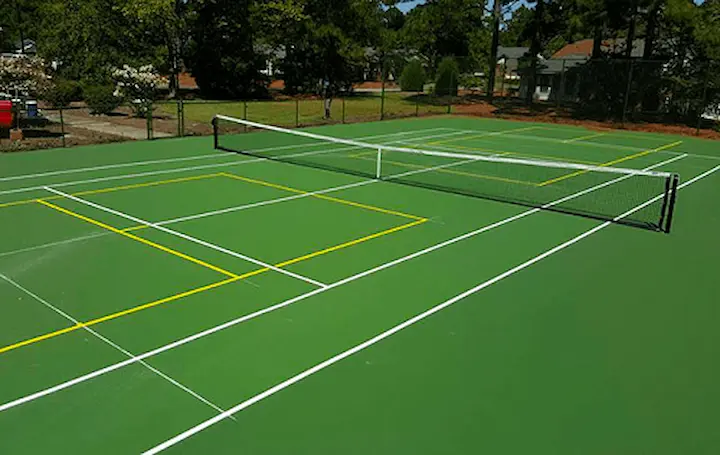What to Get Out Of Pickleball Judiciaries Style & Building in Illinois and Midwest
Secret Factors in the Building And Construction of Pickleball Courts: From Website Selection to Last Surfaces
The building and construction of pickleball courts encompasses a range of vital variables, starting with the selection of an appropriate site that balances ease of access with environmental factors to consider. Necessary components such as court measurements, surface area products, and water drainage systems significantly impact not only the quality of play but also the longevity of the facility.
Website Option Standards
When embarking on the construction of pickleball courts, it is necessary to pin down the site selection criteria that will ensure optimum playability and accessibility. The location must be conveniently obtainable for gamers, preferably positioned near houses or recreation center, to motivate participation.
Furthermore, the terrain should be degree and secure, as unequal ground can result in security risks and affect gameplay. Sufficient drain is likewise important; picking a website with great water runoff will certainly aid preserve court conditions throughout unfavorable weather.
An additional essential consideration is the availability of energies. Access to electrical power and water is required for lighting and upkeep functions. Additionally, closeness to car park facilities is important, promoting simple access for gamers and spectators alike.
Ecological aspects can not be neglected; all-natural color from trees can enhance gamer comfort, while exposure to dominating winds may interfere with play. Finally, zoning regulations and neighborhood support must be considered to make certain that the project straightens with neighborhood guidelines and obtains the support it requires for successful implementation. By very carefully reviewing these criteria, stakeholders can produce a welcoming and useful environment for pickleball enthusiasts.
Court Capacities and Format
To ensure ideal gameplay and adherence to regulations, the dimensions and design of pickleball courts have to be thoroughly defined. A typical pickleball court measures 20 feet in width and 44 feet in length for both singles and doubles play. The suggested design consists of a non-volley area, generally described as the "cooking area," extending 7 feet from the net on either side. This area is essential, as it influences player positioning and shot choice - Illinois and midwest.
The net height is set at 36 inches at the sidelines and 34 inches at the facility, developing a mild dip that influences sphere trajectory. Court markings are similarly essential; lines ought to be 2 inches broad and distinct in color to make certain presence.
In addition, a buffer zone bordering the court is suggested, commonly expanding 5 to 10 feet past the sidelines and baselines to accommodate gamers' activities and improve security. Proper format and measurements not only ensure conformity with main policies but also boost the general playing experience, suiting both leisure and competitive play. Mindful preparation in these areas is extremely important to the effective building of pickleball courts.
Surface Area Material Options
Selecting the appropriate surface product for pickleball courts is vital for guaranteeing optimum player efficiency and security. The selection of surface can considerably influence gameplay, including round bounce, traction, and gamer comfort.
There are a number of options readily available, each with its distinct features. Asphalt is a prominent option as a result of its longevity and reduced upkeep demands. It supplies a solid playing surface that can endure various weather problems yet may need routine resurfacing.
Concrete is one more extensively used material, supplying outstanding durability and a smooth coating. It allows for constant round bounce but can be difficult on gamers' joints, making it much less desirable for long-lasting play helpful resources without correct cushioning.
For those seeking enhanced comfort and shock absorption, cushioned acrylic surface areas offer a viable option. These surface areas incorporate a base layer with an acrylic topcoat, offering enhanced grip and a softer feeling, which is advantageous for minimizing the threat of injuries.
Last but not least, synthetic turf is acquiring grip, specifically for multi-purpose centers. Its convenience and lower maintenance needs make it an appealing choice, though it might not give the very same round response as conventional hard courts. Careful consideration of these choices will make sure an ideal playing atmosphere.
Drain and Illumination Considerations
Appropriate drain and efficient illumination are vital elements in the building of pickleball courts, substantially influencing both playability and safety. Sufficient drainage systems prevent water accumulation, which can bring about unsafe surface areas and damage to the court structure. A properly designed water drainage strategy integrates sloped surfaces and appropriate products to assist in water stream away from the playing location - Illinois and midwest. This not just protects the integrity of the court yet additionally lessens downtime because of poor weather.
Illumination is just as crucial, specifically for courts intended for evening usage. Proper lighting boosts visibility, making sure that gamers can see the ball clearly and lowering the danger of crashes. The placement of illumination components need to be strategically prepared to remove darkness and provide even distribution of light throughout the court. LED lights are advised for their energy efficiency and long life, providing bright lighting while minimizing operational costs.

Final Finishes and Maintenance
After dealing with drainage and lights factors to consider, interest turns to the last surfaces and ongoing upkeep of pickleball courts. Usual choices include acrylic layers and specialized sporting activities surfaces that provide optimum traction and padding.

Seasonal maintenance could include resurfacing every couple of years, depending upon use and environmental aspects. Properly preserving nets, court lines, and bordering areas website here is similarly important to offer a secure and enjoyable having fun experience. By spending in quality surfaces and sticking to a structured upkeep schedule, facility proprietors can ensure their pickleball courts continue to be in outstanding problem for years to view website find.
Verdict
In conclusion, the effective building and construction of pickleball courts hinges on precise attention to numerous crucial aspects. Quality coatings and a durable maintenance schedule are crucial for protecting the court's condition, boosting the general experience for players and viewers alike.